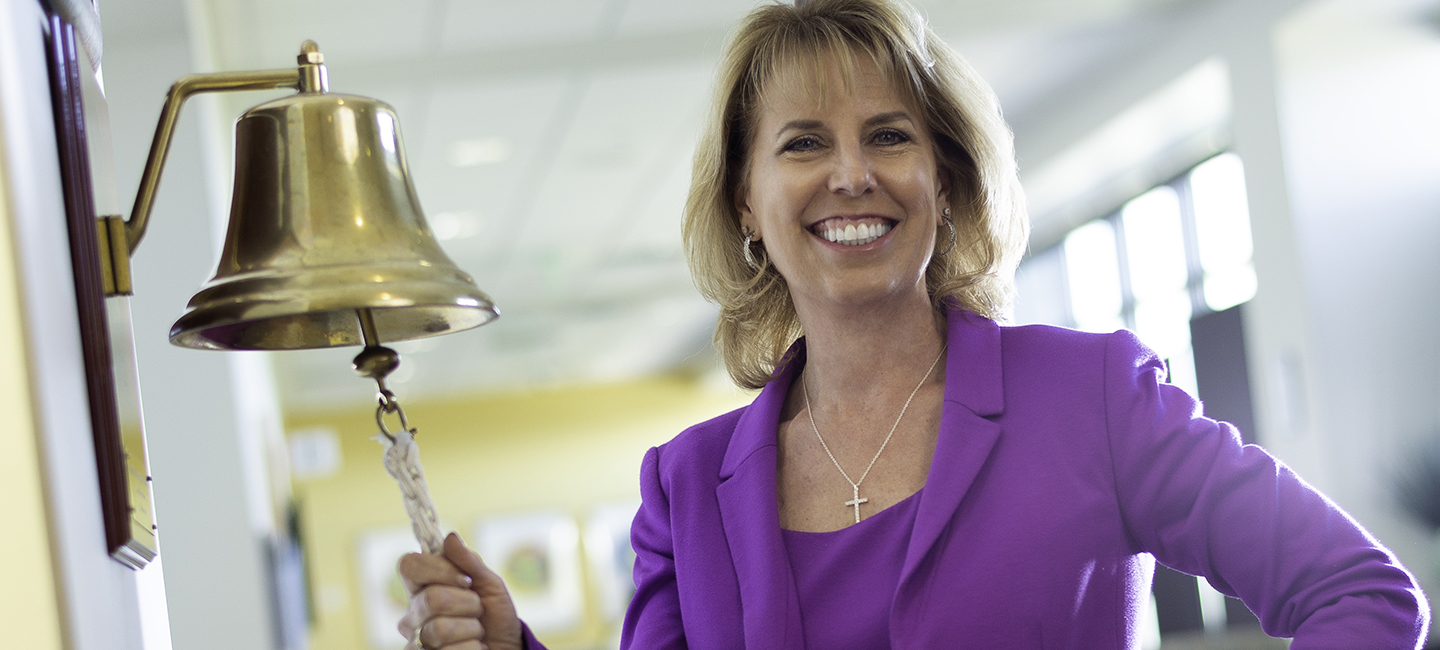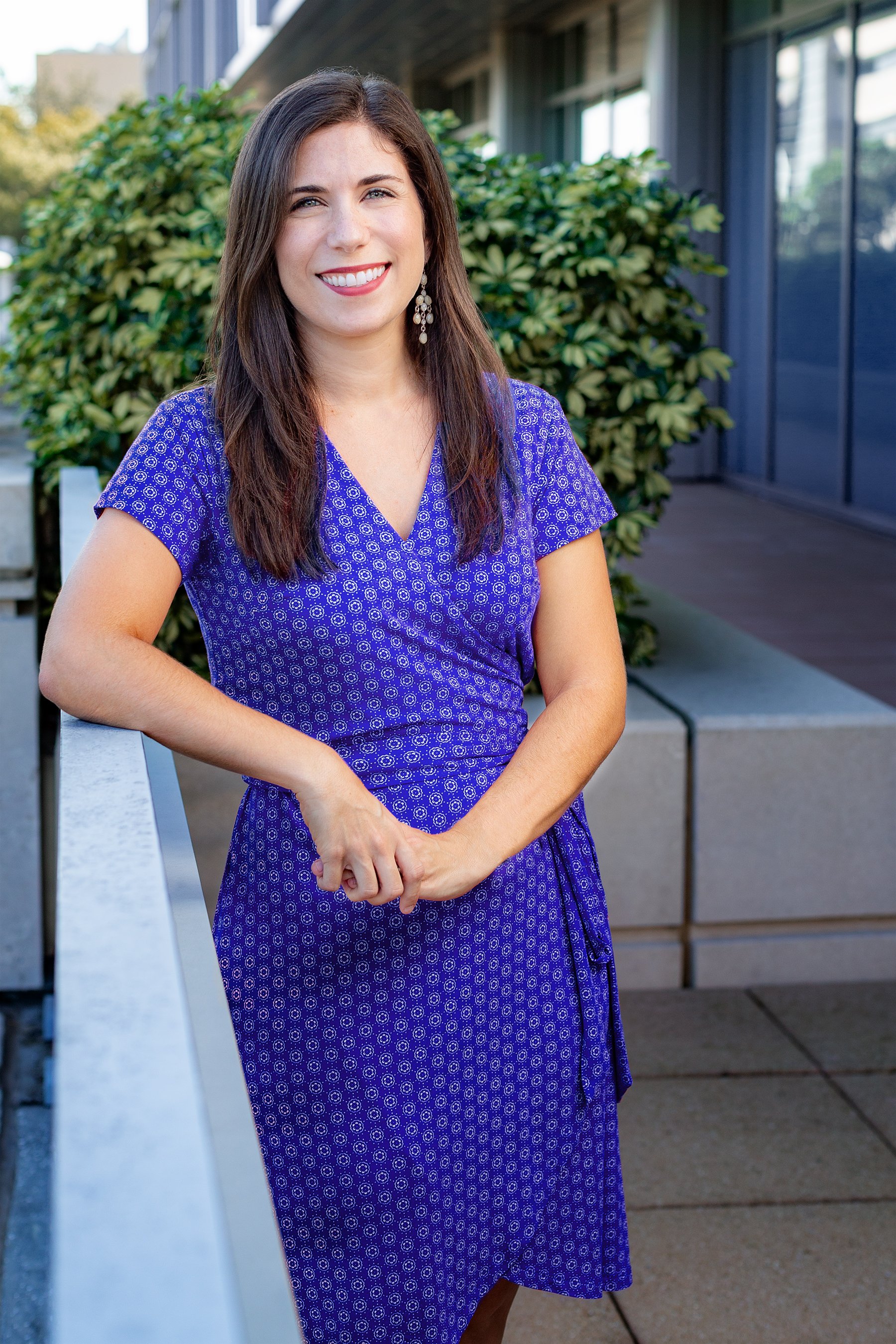The Call for Courage Bell
The moment is short but sweet. The sound is rich, resonating and recognizable.
A symbolic bell, placed at various locations across Moffitt Cancer Center’s many campuses, often marks the celebration of the end of treatment. “Victory” over cancer as many might call it.
We have come to realize that message and purpose may not ring true for every patient who walks through our doors. As diverse as our patients and the diseases they face, so too should be the reasons to take part in this tradition.
A SOBERING SILENCE
Stephanie Stanfield stood by her mother’s side throughout her battle with lung cancer at another institution, and distinctly remembers hearing patients ring the bell. It’s a common ritual at cancer centers across the nation.
For some it’s a joyous sound and cathartic experience; for others it can provoke a sobering silence within.
Stanfield recalls crying as she and her mother watched numerous families celebrate the end of treatment.
“We knew my mom would never ring that bell,” she said. In the summer of 2017, she lost both her mother and brother-in-law to cancer.
THE UNEXPECTED
That December, Stanfield began experiencing back pain. Before her mother’s passing, Stanfield had promised her she would still light up the house up for Christmas, and figured she had pulled a muscle decorating. But a routine mammogram in January 2018 revealed suspicious findings. “I think I knew right then I had cancer,” she said. She was no stranger to the disease. “I had prepared myself to be a warrior as I thought I would be scheduled for a double mastectomy. I picked out a wig. I was ready.”
After a series of tests and scans, Stanfield and her husband met with her surgeon. “When we walked in, my surgeon was crying. We sat on the couch you never want to sit on and she said, ‘It’s worse than we thought, and surgery is not an option.’ We thought, ‘How could it be worse?’ ”
Stanfield was diagnosed with inoperable stage 4 breast cancer. The disease had spread to several locations, including her spine. The diagnosis was terminal.
LIVING LIFE WITH CANCER
Known to always be a source of positivity to her two grown children, other family members and those around her, Stanfield calls herself lucky.
She recounts her blessings: “I didn’t have to go straight to intravenous chemotherapy. I didn’t lose my hair. I didn’t have the fatigue many people manifest from treatment. And I’m stable.”
“I had prepared myself to be a warrior as I thought I would be scheduled for a double mastectomy. I picked out a wig. I was ready.”
For those with a terminal diagnosis, cancer may have no true “end” in sight. But due to medical advancements, patients like Stanfield are living with cancer much longer.
Although her body will never be cancer-free, there are effective treatments to keep the cancer in check and keep her stable. Her current treatment plan includes hormone therapy to inhibit the growth and spread of the cancer, as well as oral chemotherapy to slow the progression.
“They told us the average effectiveness is 22 months,” she said. When this story was written, Stanfield was on the treatment 21 months. “You go into it knowing that the medicine is going to stop working. When it does, we’ll try something else.”
Working with her doctors, Stanfield has taken steps to improve her immune system as much as possible while undergoing continual treatment. She’s radically changed her diet, eliminating sugar, dairy, meat and refined foods. She juices every morning. “I joke and say I’m the healthiest terminal person you’ll ever meet. I really am thriving.”
A SHIFTING PARADIGM
Every three months, Stanfield visits Moffitt’s Richard M. Schulze Family Foundation Outpatient Center for treatment with Zometa®, an IV infusion drug she receives to help strengthen her bones and inhibit further metastasis.
When she came out after completing her first cycle, she told the staff at the Infusion desk, “I’m going to ring that bell.”
Staff and other witnesses began congratulating her on completing her treatment, but she quickly interjected, “No, that’s not why I’m ringing this bell. I’ll be on treatment for the rest of my life. But every month that I start another treatment cycle is a celebration for me.”
"The sound never gets old."
Stanfield once thought the bell was out of reach for patients like her mom, herself. Now she wants others to recognize it is a celebration of life, in the present.
“It’s this shift of a paradigm that I really want people to think about,” she said. “It [the bell] is not just reserved for those moving on from cancer. You can ring it for any reason, at any stage or to mark any moment you want to celebrate, big or small.”
Stanfield continues to celebrate every opportunity to enjoy life. She and her husband made one of their dreams a reality when they recently took a trip of a lifetime to Bora Bora.
SPREADING THE WORD
Mayelin Torres, a registered nurse in Moffitt’s McKinley Infusion Center, is helping to spread the same message. Being in infusion, she hears the bell day in and day out. “The sound never gets old,” she says.
Both in her career and personal life, Torres has experienced the full spectrum of a cancer diagnosis and its impact on an individual and their loved ones. Her mother was treated at Moffitt for lymphoma, and like Stanfield, her cousin is battling terminal breast cancer.
Torres wants all patients to know that the tradition of ringing the bell is accessible, regardless of their cancer stage or where they are in treatment and whether their disease is curable or not.
In a true outpouring of the heart, Torres authored a piece titled “The Call for Courage Bell,” now displayed at each bell across all of Moffitt’s campuses. “I had my mom and all of my patients in mind when I sat down to write this,” she said.
The piece embodies just what Stanfield wants to share with the world around her. “I have a terminal diagnosis. But I’m going to celebrate every day or every month I’m given.”
“Maybe this is long term, but every day you sit in these chairs, you have the strength to do that,” Torres adds. “That bell can bring forth some freedom. Understand that every day is a victory.”
The Call for Courage Bell
I ring this bell as a symbol of perseverance
It takes a great deal of strength and dedication to
walk through these doors and
accept this journey as the new normal.
I ring this bell for my fellow patients
For those who have walked, are walking or will walk
the journey of a cancer diagnosis.
I ring this bell in celebration of the little victories and the big victories
Receiving good news, reaching that milestone at the
end of treatment or just celebrating that today is a
good day.
I ring this bell to say thank you to my family and friends
It is not alone that I could have done this, or
continue as such. It is coupled with the love and
devotion that my family and friends have provided
through this often very difficult journey.
I ring this bell in appreciation of the staff
It takes a special team to provide care to patients
during this time. The medical and ancillary staff
has been constant in their care delivery throughout
the process.
I ring this bell as a symbol of acceptance and faith
I cannot control what the future holds but I am
thankful for today.
Author: Mayelin Torres, MKC Infusion RN



